[mashshare]
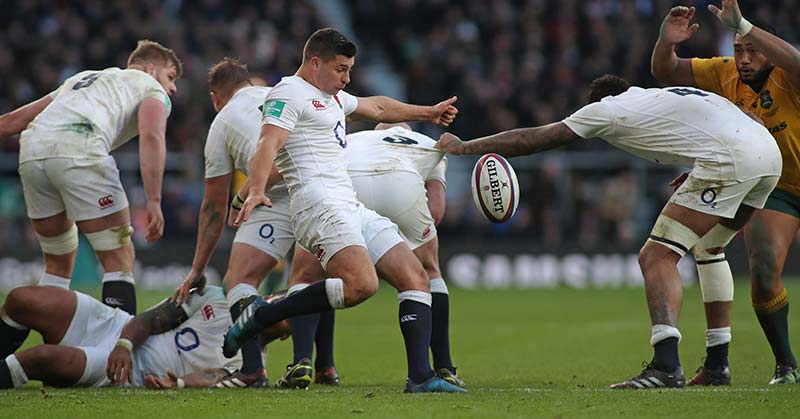
Everybody seems to be process-driven, and sometimes I worry because I am not. Without a doubt, outcomes are and have always been my driver. I struggle with the concept of putting a process in place so the outcomes take care of themselves. Surely your starting point should be outcomes—how can you even begin to define a process without knowledge of what that process should produce?!
In my early years of S&C, outcomes were easy: a heavier squat, more muscle mass, less body fat, increased aerobic power output, etc. This changed dramatically after a conversation with Professor Yuri Verkhoshansky. I had been questioning the relevance of squat strength to rugby union, assuming it was important and that strength levels would directly impact my players’ abilities. He made two points that stick with me to this day and define how I have tried to work ever since:
- “The squat strength of rugby players should be very strong, but this strength is a side effect of the training you perform and not the measured outcome.”
- “The transfer of strength to a sport will depend on how strength is developed. With bodybuilding, this means there can be little transfer; developed through explosive methods there is much greater transfer.”
This made me realize I needed to consider two essential factors in my programming and planning. The first was a sport-specific outcome measure that measured the success of my program. The second was a realization that the way in which you develop physiological qualities is at least as important as the qualities you develop.
Before introducing any process of training, you need to determine your desired outcomes. Share on XIt made me realize that I had to find my outcomes before any process of training was introduced.
Finding an Outcome
Prof. Verkhoshansky’s most-reproduced illustration shows clearly labeled outcomes (Figure 1). The factor “W” is a sport-specific quality that relates directly to performance.
In a distance runner, this sport-specific outcome could be velocity at aerobic threshold. In a sprinter, it might be maximum velocity or time to achieve maximum velocity. “W” is always sport-specific, and it relates to the ability to improve sports performance.
In team sports, finding your “W” is a little more difficult. People might correctly state that all that matters in team sports is the result at the end of the match. Unfortunately, this may not truly reflect the success of a physical development program. Most would agree that budget and recruitment likely have a greater impact on results than any S&C program or system.
For a long time, I persevered with measures of jumping ability or explosive strength, and these had definite advantages in monitoring and predicting performance. However, I have since concluded that they only indicate readiness, and any change in performance probably results from recovery and not a change in actual playing ability.
Over the last 26 months I have gone further, spending a considerable amount of energy and time attempting to determine which on-field actions differentiate good teams from not-so-good teams. What aspects of the game are the champions able to carry out that the also-rans cannot? With knowledge of the on-field actions that have the biggest impact on game result, I should (with enough data) be able to correlate or regress this information alongside players’ physiological abilities and discover which (if any) physical abilities really impact the game of rugby.
I can already hear the purists screaming at me, “Correlation is not causation!” I know this, but it’s a step forward from measuring readiness and two steps on from squat strength. The proof of the pudding comes when development of these physiological abilities produces corresponding changes in measured on-field actions (or doesn’t!).
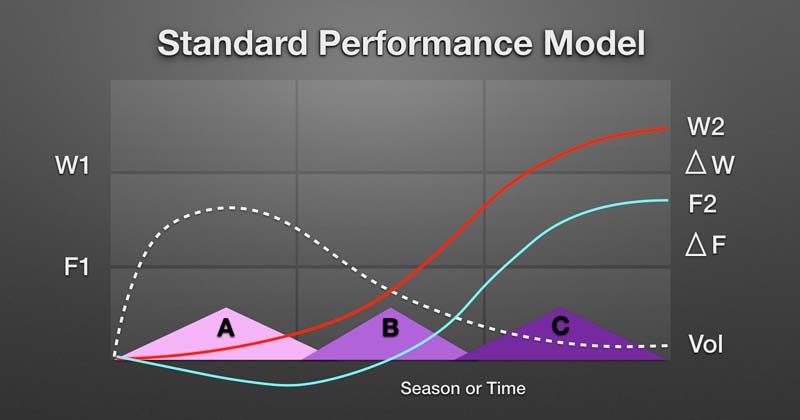
At this time, I have a small regression equation that defines critical actions. By this, I mean it examines and differentiates between the actions all teams can do and the actions that only the best teams do well. It explains a large variance in the points accumulated this year in the Premier League; this confirms to me that these critical actions can be thought of as my “W.”
With this as my marker, I can go a step farther and look at which physical abilities actually predict a player’s performance in these critical actions. The following tables show summaries of these results. The statistical outcomes used physical data and on-field activity from 50 international rugby players.
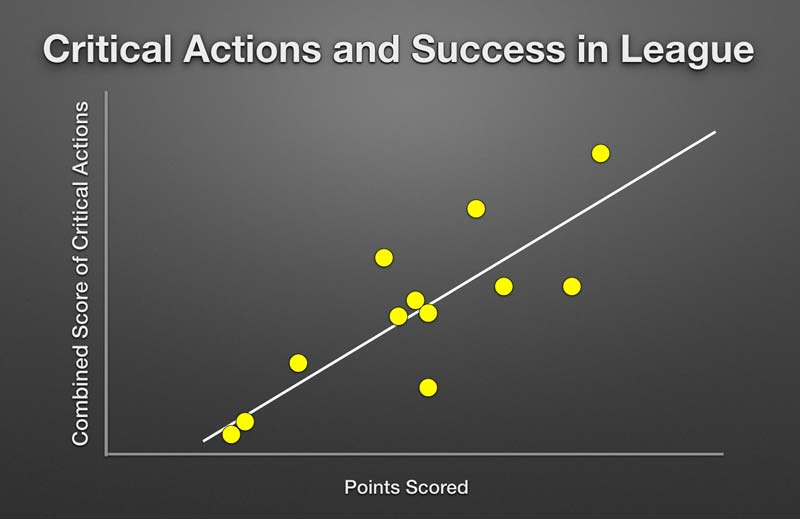
Physical Ability and On-Field Performance Markers
From the regression, we can determine that a model based on physiological ability explains around 40% of player variability in critical actions. In a game like rugby union, it’s not too surprising that 60% of this ability remains unexplained; the best players have the physical abilities, plus the technical and tactical awareness to make the best of these physiological qualities. In reality, 40% still gives us a large proportion to try and improve on.
Relative peak power output appears to be an important quality in rugby players. We can examine its relative contribution in comparison to other measure of physical ability (Figure 3).
Type of Training to Improve Critical Game Actions in Rugby Union
Current paradigms instill in us the importance of being specific in the work we do. So, normally we would look at a series of rules to define specific work and produce a selection of exercises and a plan of action based around them. There is an issue with this. I looked through some data regarding training times and where we apply most of our effort in the sport of rugby union. One calculation stood out for me: On average, we spent 84% of our available time performing sport-specific training and 16% of our time on general work.
This calculation assumes that all the work we did in the gym was classified as general (which would not be the case), so my statement would read: More than 84% of available time doing specific work, less than 16% doing general work. This says to me that I should use the small amount of time I have available performing general exercises that give me the most “bang for my buck.”
It probably explains why, over the years, instincts led me to always have squats, dead lifts, or cleans in my program. I am not a big prescriber of unilateral work—it’s not that I don’t think it offers something, it’s more that I feel that don’t cover as many bases. Besides, players spend 84% of their training time doing unilateral or offset activities like running, cutting, and jumping.
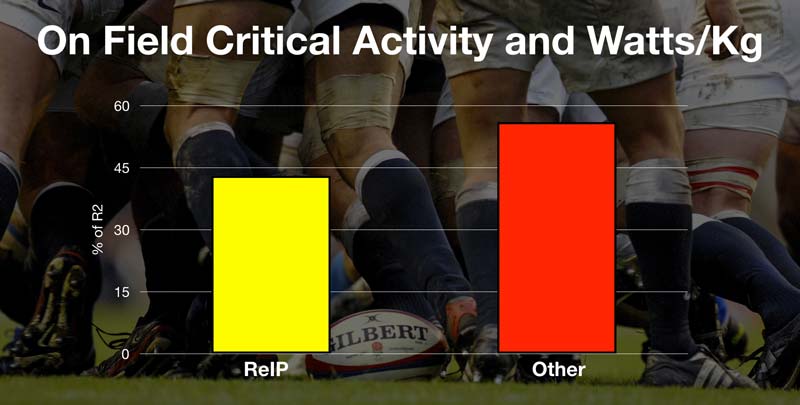
If I can’t put in place exercises that are specific to movement patterns when classified according to joint angle, amplitude of movement, muscle work regimes, etc., I still try to focus on producing an athlete engine that is specific to needs and requirements. Thinking about the engine required, it is important to realize that critical actions involve other players. We attempt to move them in some way, whether through tackles or ball carries, and we generally work against heavy objects that weigh between 80kg and 130kg.
With this in mind, I feel much of my time needs to focus on being good at moving objects within these boundaries as fast and explosively as possible. This includes explosive squat jumps, clean and jerk, clean grip power snatch, etc. Sometimes I feel you don’t even need to be that specific about the relative ability of each player. If you’re weak and can’t move those loads fast, it becomes a maximal strength session (and that’s what you need). If you’re very strong and can move the bars quickly, then you’re not wasting time chasing maximal strength—you’re improving peak power output!
The data clearly illustrates that having high levels of peak power production relative to body weight is an advantage for rugby union players. There are several adaptations that can result in improved power output. These include:1
A. Motor unit synchronization
B. Frequency of stimuli from CNS
C. Inter/intra muscular coordination
D. Golgi tendon inhibition
E. Rainshaw cell influence morphological structure of muscle (% fiber type)
When looking at adaptation, I have always favored Verkhoshansky’s idea that morphological adaption is more meaningful; it allows greater latitude for long-term development and changes may possibly be maintained for longer during detraining phases.
This has always made me curious about changing distributions of fiber types. We know that it’s probably not possible to change the number or percentage of type 2a fibers. We can, though, hypertrophy type 2 fibers selectively or preferentially over type 1 fibers, and different exercise protocols can impact the relative hypertrophy that occurs.3,4,5,7 An elite athlete has demonstrated this.2
The best explanation I have read for an improvement in athletic ability when we preferentially increase the size of type 2a fibers comes from Carmel Bosco’s manual concerning the Bosco jump test. If you have not read this and want to improve maximal power outputs in athletes, it’s a fantastic resource and bests or matches any current literature.
According to Bosco, consider two subjects pushing one cart, with one subject fast (10m/s) and the other slow (5m/s). When they begin to push the cart at a slow pace, both can apply force. At speeds above 5m/s, the slow subject can make no contribution—he is a passenger and the fast subject does all the work. If both perform a hypertrophy program they can push harder at slow speeds, but at higher speeds the extra weight of the slower passenger he must push negates the impact of the hypertrophy of the fast subject. Only if we enhance the muscle mass of the fast subject will force then improve at high and slow speeds.1
How Do We Induce Preferential Hypertrophy of Type 2a Fibers?
We can use Zatsiorsky’s explanation of the recruitment and hypertrophy process to envision how we can put together training programs that give us the potential to produce specific hypertrophy of type 2 fibers while minimizing changes in type 1 fibers.6
A. Training adaptation will only occur if magnitude of stimulus is above the habitual level (progressive).
B. Only fatigued or exhausted fibers will receive stimulation to adapt. Muscles fibers recruited but not fatigued will not adapt.
C. The rate of fatigue is differential between fast and slow fibers.
If we examine Figure 4 and Rules A, B, and C, we can safely conclude that the most effective way to stimulate the largest, most powerful motor units will be through high-force movements. We need to do enough work to fatigue these motor units, but not enough to fatigue the smaller, more fatigue-resilient, slower motor units. This way we can induce selective hypertrophy and improve power or explosive strength.
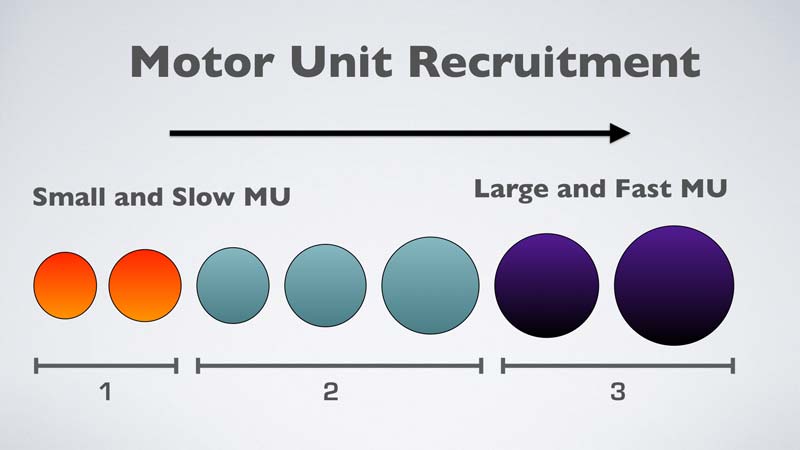
There are, of course, two possible ways that we can produce high-force movements through mass or through acceleration. Acceleration is an excellent method to stimulate many neural adaptations associated with improved power output. It does not, however, place enough mechanical stress on the muscle to degrade protein structures (at least in low rep sets) and ensure fiber hypertrophy.
We need to stimulate and fatigue large fibers with heavy weights, and terminate work at a point before fatigue accumulates in smaller, slower fibers. This sounds suspiciously like velocity-based training. Is it possible the success we achieve with velocity-based training is due to selective fiber hypertrophy, rather than simply being due to “moving the bar quickly,” which is apparently sport-specific?
Changes in the type 2a fiber cross-sectional area have been demonstrated after velocity-based training based on a 20% fall in bar speed. There was no change seen with a 40% drop in bar speed.8 Unfortunately, the differences at the end of the study were not large enough to be significant.
Can Weightlifting Offer a Solution to Training for Peak Power and Selective Hypertrophy?
Weightlifting is an extremely effective method for developing power. It has been shown to be more effective than traditional resistance training methods, and results in greater performance improvements.9,10,11 Weightlifters have also demonstrated preferential hypertrophy of type 2a fibers.12
Coaches frequently discuss the triple extension in Olympic weightlifting, and its specificity in terms of movement pattern to many sports actions such as jumping and sprinting. The triple extension is frequently quoted as the reason weightlifters can jump so high. The reason that weightlifters jump so well may be more related to the specific hypertrophy of type 2a fibers than to practicing the triple extension. The Kazakhstan lifting team believes that training should be planned with the specific hypertrophy of type 2a fibers as a desired and essential outcome.13
Weightlifting as a training methodology for sports tends to divide coaches. I don’t think weightlifting is essential, but it is a tool to use with the right individuals who have the motivation and ability. It’s also a tool with some unique qualities. I think it is important that coaches realize that placing some power cleans into their program does not make it a program based on weightlifting, no more than adding chins means your program is gymnastics-based. If you are not using a weightlifting program, then you will not see the benefits.
Where possible, I prefer to choose weightlifting exercises that are self-regulating and thus ensure the same benefits as VBT without the need for measures. By self-regulating, I mean that an athlete can only complete the lift while fatigue levels are low and speed of movement is high; this way, I am assured of fatiguing and promoting adaptation in type 2 fibers only.
If, for example, we compare clean and jerk to a clean pull with a prescribed weight of 85% max, you will not be able to clean and certainly not be able to jerk the bar once velocity begins to fall. Type 2 fibers are essential in the movement and, as such, when fatigued the set terminates whether you like it or not. On the other hand, a clean pull allows you to keep moving and “succeeding” at the lift even when velocity falls past “critical.” If you include lifts that are not self-regulating in your program and your desired outcome is preferential hypertrophy, it’s essential to monitor speed of movement. If you can’t do this, lifts need to be low in repetition range (less than three to four reps).
Lifts that I would personally class as self-regulating are:
- All variants of classic lifts—snatch, clean, and clean and jerk
- Power snatch, clean grip power snatch
- Power clean and jerk or power jerk
Can Weightlifting Offer Any Other Advantages When It Comes to Peak Power Production and Rugby?
- You will likely handle weights that are close to those in a game (bodyweight of other players). This places you in an area of the F/T curve that is specific to the sport. This is not the case with medicine ball work, ballistic exercises, or plyometrics. In terms of power requirements for critical actions in rugby union, it was interesting to note that RSI was only classed as an indicator when peak power output was excluded from the calculations. It had a high co-correlation with peak power and simply indicates players most likely to have the greatest relative peak power outputs, rather than being a defining factor. I am keen to look at a larger sample of elite payers, but currently these results downplay the need for plyometric training.
- Clusters, which we know are a great way of developing power and explosive strength, are natural to the exercises. Not too many people will complete 3x clean and jerks without stopping to catch their breath!
- We know that we have to be strong at different joint angles, and areas of accentuated force can change dramatically in team and combat sports where the positions that start and end critical actions will continually change. This can be covered in weightlifting. A complex is a fantastic opportunity to do this in one set: 3x clean and jerks can easily be prescribed as Rep 1) power clean from hips and power jerk; Rep 2) clean from knees and jerk; and Rep 3) clean from floor and jerk. This offers an instant solution to training varied joint angles and regions of accentuated force production.
We cover a lot of bases with a single exercise. For example, six sets of the above complex are 18 reps. In this, we cover at least the same ground as you would with RDL, front squats, and push press.
If you have a healthy athlete with no mobility issues, coaching lifts is easy. If you are having issues, you probably need to revisit your coaching technique rather than blame the difficulty on Olympic lifts.
Producing Your Desired Outcomes
Ensure your process produces the outcomes it should. Have measures in place that gauge your success and allow adjustments to your program to maintain progression and direction.
- Define your outcome measure.
- Investigate what physical abilities relate to the sport-specific outcome in your athlete population.
- Determine how to train these abilities in a manner specific to your sport, what the cost of general fitness and training is to your base, and whether you compensate for any issues through exercise selections or training moralities that give you “bang for the buck.”
- Is your program doing what is says on the tin? Does it improve peak power outputs of players relative to body mass?
- Do improvements in athletes’ physical abilities produce improvements in critical activities? If not, change the way you train.
- Do improvements in critical activities lead to better results? If not, revisit your critical activity analysis.
I hope that this has given insight into the way I view putting a training process together and how I measure a successful outcome. There are many ways to skin a cat and many are successful. I think it’s vital that we all learn to think through and justify our processes and decision-making, rather than relying on simply regurgitating what is spun on Twitter without any thought to the “what” and “why.”
Please feel free to contact me with any queries or questions. If you are keen to read more into selective hypertrophy, I suggest Dr. József Tihanyi’s paper, “Development of explosive strength according to muscle fiber types.”
Since you’re here…
…we have a small favor to ask. More people are reading SimpliFaster than ever, and each week we bring you compelling content from coaches, sport scientists, and physiotherapists who are devoted to building better athletes. Please take a moment to share the articles on social media, engage the authors with questions and comments below, and link to articles when appropriate if you have a blog or participate on forums of related topics. — SF
[mashshare]
References
- Strength assessment with the Bosco’s Test, Carmelo Bosco. The Italian Society of Sport Science 1999.
- Fiber type characteristics and myosin light chain expression in a world champion shot putter. Int J Sports Med. 2003 Apr;24(3):203-7.
- Effects of strength, endurance and combined training on myosin heavy chain content and fiber-type distribution in humans. Eur J Appl Physiol. 2004 Aug;92(4-5):376-84. Epub 2004 Jul 6.
- Muscle hypertrophy in bodybuilders. Eur J Appl Physiol Occup Physiol. 1982;49(3):301-6. Eur J Appl Physiol Occup Physiol. 1979 Jan 10;40(2):95-106.
- The effect of weight-lifting exercise related to muscle fiber composition and muscle cross-sectional area in humans. 6. Science and Practice of Strength Training. Zatsiorsky. Human Kinetics 1995.
- The Role of Resistance Exercise Intensity on Muscle Fiber Adaptations. Sports Med 2004(10) 663-679
- Effects of velocity loss during resistance training on athletic performance, strength gains and muscle adaptations. Scand J Med Sci Sports. 2016 Mar 31
- Olympic weightlifting and plyometric training with children provides similar or greater performance improvements than traditional resistance training. J Strength Cond Res. 2014 Jun;28(6):1483-96
- J Strength Cond Res. 2014 Jun;28(6):1483-96. J Strength Cond Res. 2004 Feb;18(1):129-35.
- Olympic weightlifting training causes different knee muscle-coactivation adaptations compared with traditional weight training. J Strength Cond Res. 2012 Aug;26(8):2192-201
- Unique aspects of competitive weightlifting: performance, training and physiology. Sports Med. 2012 Sep 1;42(9):769-90
- Scientific – Methodological Aspects of Training the Kazakhstan Select Team. Bud Charniga. Sportivny Press 2014




